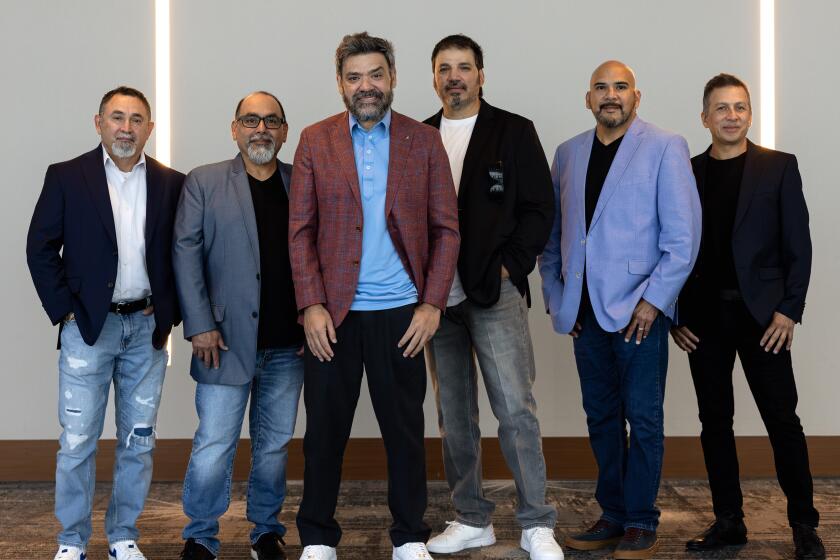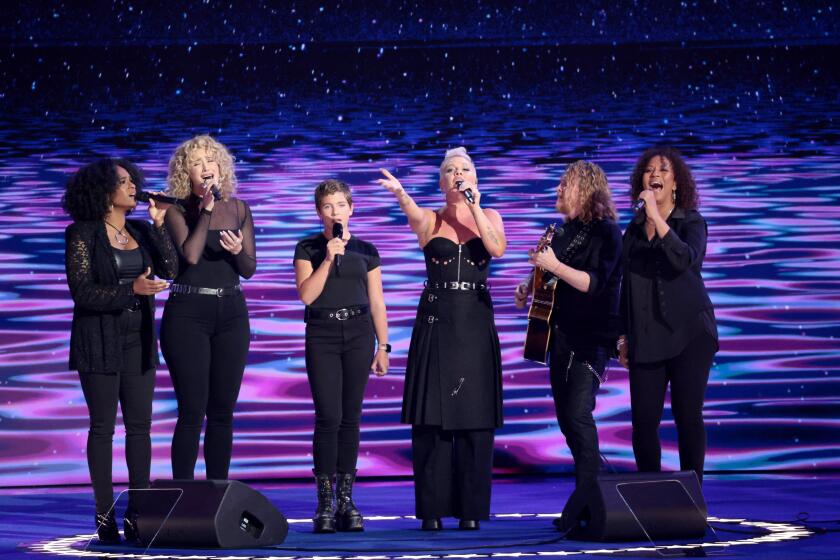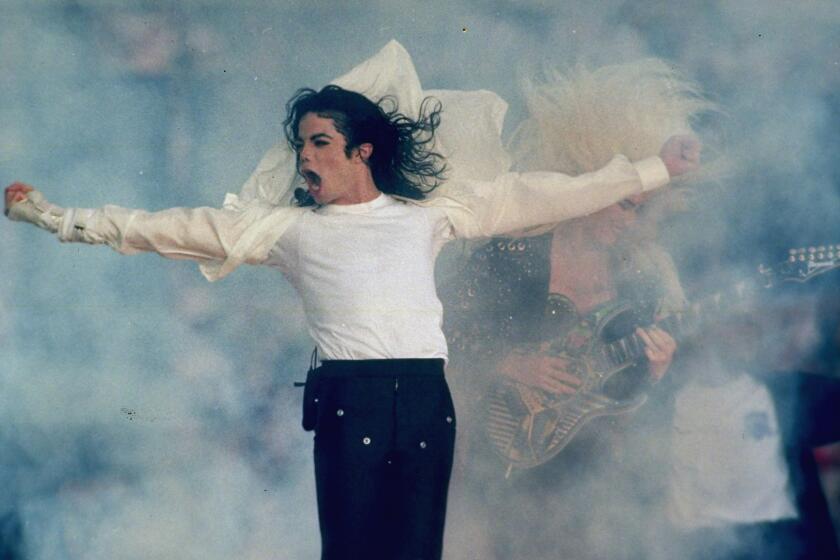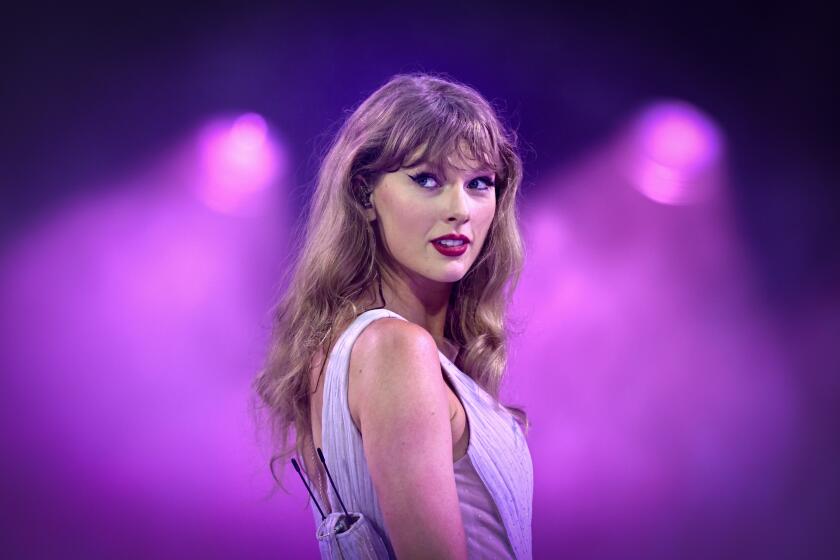MUSIC CITY : Raucous, Racy New Orleans Offers Great Food and Music Year Round--but During Jazzfest, the Volume Really Goes Up
THE FIRST PROBLEM IS THAT YOU, SITTING AT home, can’t hear the drummers. They stand in loose formation onstage--one of the 11 stages that the New Orleans Jazz & Heritage Festival’s organizers put up every spring at the city’s fairgrounds--and when they’ve settled properly into a groove, time bends into a repeating loop. Their energy and yours multiply. Even the humidity, greatest of all natural forces in these parts, begins to seem irrelevant. And while the “Mardi Gras Indian” drummers (black New Orleanians who dress in fanciful Native American costumes for public events) pound and paradiddle, a clutch of dancers shimmies in sequined costumes. Red. Green. Gold. Blue. Silver. A bare-bellied woman, ample and undulating. A prancing boy with doe’s eyes. All in thrall to those drummers.
You can’t smell the gumbo, either. On a late April afternoon, the aroma hangs around the long row of food booths on the grassy fairgrounds infield, mingling with whiffs of red beans and rice, alligator sausage, peanut soup, fried plantains, artichoke-spinach casserole, sweet potato pie, jambalaya, oysters, crawfish, soft-shell crab, strawberries dipped in chocolate. On a typical day at Jazzfest--as the event is known in local shorthand--perhaps 30,000 customers converge on the fairgrounds, beginning about 11 a.m., their pockets stuffed with dollar bills to spend on such snacks. When the music stops at 7 p.m., they leave, ears ringing and bellies bulging, to confront an evening in the single American city most likely to exacerbate those conditions.
So sound and smell are problems, and until word processors can directly deliver those sensations in full glory and subtlety, typing will remain a crudely inefficient way of communicating the appeal of the New Orleans Jazz & Heritage Festival. Which is why I’m resorting to props.
Can we have the evidence out front, please? Exhibits A, B and C are three smiling faces: one black, one British, one mud-caked.
*
EXHIBIT A IS MAHALIA JACKSON--A WOMAN WITH A ROUND FACE WITH kind eyes and formidable mouth, seen in a snatch of old black-and-white video footage.
Jackson grew up in New Orleans. Before she died in 1972, her loud, sure voice made her the nation’s most famous singer of black gospel music. Thus in 1970, when jazz impresario George Wein set about organizing the first Jazzfest (originally known as the Louisiana Heritage Fair) as a musical celebration of that region’s rich cultural mix, jazz and otherwise, he called Jackson. She came in for an evening solo concert, which came off as planned. But on the day after her performance, Jackson appeared again, as a member of the audience at Congo Square, then the venue of the festival’s daytime events. Congo Square is where slaves and laborers gathered in centuries past to make some of the first African-American music heard on this continent. It was, and is, near some dispiriting slums, and on this day in 1970, the scene was not auspicious. The audience amounted to fewer than 1,000 people, gathered to hear the uniformed men of the Eureka Brass Band. Jackson, spotted in the crowd, was soon urged to join them in “Just a Closer Walk With Thee.”
Given the secular and fledgling nature of the event, she might have declined. Instead, Jackson beamed, raised her famous voice amid the strains of several white-hatted brass players and set a precedent of cooperation and informality that endures a generation later.
“To me,” festival producer-director Quint Davis said later, “that was the eternal spark of what the whole festival was going to be about.”
This year, the New Orleans Jazz and Heritage Festival will celebrate its 25th anniversary with a run from April 22 through May 1. The program, which includes the Neville Brothers, Little Feat, Little Richard, Aretha Franklin, B.B. King, the Allman Brothers and Wynton Marsalis, will follow a much-beloved pattern: Performing outdoors, indoors, alone and in 150-voice choirs, about 5,000 well-known and unknown musicians will deliver rhythm and blues, gospel, Cajun, zydeco, Afro-Caribbean, Latin, rock, country and bluegrass music to audiences assembled from around the world.
The busiest stages will be the 11 at the fairgrounds. Beneath one tent near the fairgrounds entrance, only gospel music is heard; in another, the emphasis is folk. Jazz has a stage of its own, but despite the festival’s name, that type of music is only one ingredient in this recipe, and not the dominant one. Each performer’s set usually lasts 45 to 90 minutes, and the single greatest achievement of festival organizers may be their effectiveness in cajoling those thousands of musicians through such a precise program.
In quieter corners of the fairgrounds, workshop coordinators lead sessions on Caribbean percussion or storytelling for children (every year, there seem to be more, and younger, children at the festival), or jazz history. Craft workers arrange displays of kente cloth, Guatemalan fabrics, earrings, prints and good-luck charms. In the evenings, after the fairgrounds close, some of the performers take over half a dozen venues around town to deliver longer concerts at higher prices.
The festival now rivals Mardi Gras as a magnet for visitors, bringing in more than 360,000 every year, about 40% of them from out of town. In fact, if you haven’t got hotel and air reservations yet for this year’s event, you’re probably better off considering 1995. The faithful do their booking as early as a year ahead, and you may recognize them by their smugness.
“I don’t know where you will be three to four weeks from now,” wrote repeat festival-goer Nathan Cobb in the Boston Globe last April, “but I know where I will be. And my place will be better than your place.” It’s an annoying sentiment, I know, but I share it. The New Orleans Jazzfest has been my place, too, for three of the past four years.
EXHIBIT B IS THE UNCLEAN FACE OF PHIL COSTELLO, 27, OF PLEASANTON,Calif., and I won’t forget it because I have it in several photographs. Should Phil ever be nominated to serve as attorney general, they will become valuable.
Phil was part of our traveling party to last year’s festival. He hadn’t been to New Orleans before and hadn’t much studied its musical traditions, but thought the enterprise sounded like a good chance to unwind. Then came the rains--hours and hours of them, which soaked the fairgrounds until it seemed as if the surrounding swamps were massing to retake the city. Thousands of would-be festival-goers stayed inside. But the show went on, we turned up and a healthy sense of abandon took hold. Soon, while the Neville Brothers slipped into a smooth rhythmic groove, scores of dancers were casting off their rain slickers, sliding atop the mud, diving into the mud and ultimately frolicking caked in mud, head to foot.
Shortly after this began, Phil received a polite invitation from two rather forward young women, one each from Texas and Louisiana. After a few moments of chat, Phil handed me his wallet, folded a $10 bill under his hat and assured me that he’d find his own way home. Then he made for the mud. Before we parted ways, I caught a look on his face that I have seen before in New Orleans: I have been given a chance to overlook certain conventions of civilized behavior , this look told me, and I am taking it .
This is not to suggest that Jazzfest leads to activities any more reckless than are found along Bourbon Street any other week of the year. New Orleans is a city whose bars have no legal closing time, after all. A city whose economy is largely built around the idea of tourists drinking in the streets from plastic cups, and a city where a Roman Catholic holy day--Shrove Tuesday, the last day before Lent--has exploded into the two-week orgy of formal balls, street parades, masked reveling and all-purpose, around-the-clock overindulgence that is Mardi Gras.
Yet there is more to New Orleans than dissolution, more to it than the 69 bars of the French Quarter and the 2,500 restaurants said to be found within a 50-mile radius of the central city. Architecturally inclined visitors take the St. Charles Avenue streetcar past sprawling willow trees and elegant Garden District homes to the end of St. Charles Avenue and back. The faithful step into St. Louis Cathedral at Jackson Square, where the French founded the city in 1718. The culturally inclined stroll through the New Orleans Museum of Art, the Contemporary Arts Center, the art galleries in the Warehouse District, the antique shops of Royal Street, the river-side Aquarium of the Americas, the Audubon Zoo.
Still, it’s some of the other things about New Orleans that work on so many people’s imaginations--the gravestones stacked above ground because the cemeteries lie beneath sea level; the simultaneous cosmopolitanism and parochialism of the people; the obscure allegiances of the neighborhood krewes (community fraternal organizations) that throw the Mardi Gras parades; the 20th-Century poverty beyond the 19th-Century balconies and wrought-iron curlicues; the idea that once one leaves the French Quarter, charm may yield to menace, and menace to charm, three times in the space of a short, narrow block.
Against this backdrop, a jazz and heritage festival begins to seem as wholesome and stable an enterprise as dairy farming. Though Jazzfest pilgrims do tend to clog up the most popular restaurants and crowd the clubs to bursting, they overtake the city with a back-to-summer-camp familiarity and impose something like order on a notoriously random place. The shrewd veterans lean toward tennis shoes, T-shirts and sweat shirts, and the women leave their purses at home, carrying instead knapsacks and fannypacks stuffed with sun block, sun visors, rain ponchos, perhaps a camera. Some insist on rental cars and do battle daily over limited fairgrounds parking; others count on the Gray Line shuttle buses that run between the fairgrounds and the French Quarter. (Round-trip fares last year ran $5 to $6, depending on the point of departure.) Some spend their days sleeping and eating, go clubbing by night and never do get to the fairgrounds. Others linger all day at the fairgrounds, dine late and never make it to a club or concert.
The pilgrims make an interesting family: Ed Bradley, the newsman from “60 Minutes,” has been a Jazzfest regular for years. Singer-songwriter Paul Simon has turned up in the audience, as has actor John Goodman (who, standing a foot taller and weighing about 100 pounds more, is substantially easier to spot). Michelle Pfeiffer and Matt Dillon have been around, too. And for every celebrity, there are a dozen anonymous and deeply serious aficionados--people like the young man I met by the mixing board at a club performance by the Radiators last year. His name was Mark, and he had arrived two hours before, he said, after driving more or less straight from Winter Park, Colo. What was he so excited about? The chance to plug his fancy tape recorder directly into the Radiators’ soundboard, thereby making his own tape of the band’s performance. Four other tape recorders were piggybacked onto the same output line, evidently with the band’s permission. Up to that night, I thought only the Grateful Dead inspired and encouraged such devotion. But when music lovers convene in New Orleans, the demonstrations of devotion can get lavish indeed.
*
WHICH LEADS US DIRECTLY to Keith. I’m operating strictly from memory here, but I remember a jowly oval of a face, a grayish goatee and an expression of rapt happiness. Keith, whose last name I don’t know, is from England. But every year for Jazzfest, he crosses the sea to spend several days more or less worshiping the New Orleans-based soul singer Irma Thomas.
There has never been any question about where such worship should take place; Thomas and her husband, Emile Jackson, own a bar called the Lion’s Den. The club lies in a neighborhood that would, and should, intimidate most tourists, but late on Jazzfest nights, the Lion’s Den fills with out-of-towners who have decided that eight hours of music a day is not quite enough. The pilgrims pay the $10 cover charge, crowd into a space the size of a three-car garage and line up for free red beans and rice while they wait for Thomas and her band, the Professionals, to start up. When the lights go down and the Professionals start vamping, Keith will usually be found down front in an autographed, paunch-stretched Irma Thomas T-shirt, a beer in hand.
Together, Keith and the rest of the audience wait for the ritual opening: Tall, courtly Jackson leads his wife by the hand to the lip of the stage. Then Thomas, a remarkable and underappreciated talent, adds her leonine shouting, whispering and growling to the music. Into bliss goes Keith.
Flash back now to the second Friday of last year’s festival. A cab delivers my wife and me to the Lion’s Den. We grab two seats near the stage and make the acquaintance of our waitress. The Professionals assemble and give us several warm-up songs. Then a pause. We know what this means, and we look for Emile’s emerging profile.
But instead, Emile hangs back, and we behold the Lady of the House approaching the stage, and beaming like a bride . . . on the arm of our man Keith, who grins the grin that I now submit as Exhibit C. Up they step, the Queen and her ennobled supplicant, to a splash of vigorous, knowing applause. Keith looks as if he might die of acute satisfaction, but he lives and takes his seat down front. Away flies the night.
GUIDEBOOK
Way Down Yonder
*
Prices: Hotel prices are for a double room for one night. Restaurant prices are for dinner for two, food only. Many hotels boost their prices during jazz festival dates.
*
Getting there: United and Delta Airlines each offer one nonstop flight a day from Los Angeles to New Orleans.
*
Where to stay: Windsor Court, 300 Gravier St., (800) 262-2662 or (504) 523-6000. A luxury option. More than 300 rooms, 90% of them billed as suites, near Canal Street and the Mississippi riverfront. Noted for good service and rated second-best in the nation in the 1993 Conde Nast Traveler readers’ ranking of hotels. Rates: $250-$450. Hotel Provincial, 1024 Chartres St., French Quarter, (800) 535-7922 or (504) 581-4995. One hundred and six rooms, including suites and condos. Rates: $105-$130 ($140-$175 during the jazz festival). Soniat House, 1133 Chartres St., French Quarter, (800) 544-8808 or (504) 522-0570. An 1830 townhouse with 24 rooms. Rates: $135-$350($155-$375 during Jazzfest, for which rooms usually are booked up a month or more in advance.) For further options, ask for literature from the Greater New Orleans Tourist and Convention Commission (address and phone number below), or call Central Reservation Service, (800) 548-3311, a Florida-based firm that handles hotel bookings for dozens of properties in New Orleans, or Bed & Breakfast Inc. Guesthouse & Reservation Service, (800) 749-4640.
*
Where to eat: Beyond the festival food booths, three top restaurants are Bayona, 430 Dauphine St., French Quarter, (504) 525-4455, eclectic Mediterranean cuisine, $50-$60; Brigtsen’s, 723 Dante St., (504) 861-7610, modern Louisiana cuisine, $60, and Commander’s Palace, 1403 Washington Ave., (504) 899-8221, a Garden District Victorian mansion that serves up “Haute Creole” cuisine, $70-$80. Two newer favorites are NOLA, 534 St. Louis St., French Quarter, (504) 522-6652, serving “new Creole American” food, around $50, and Mike’s on the Avenue, 628 St. Charles Ave., (504) 523-1709, Southwestern, Asian and Louisana influences, around $75. For 24-hour snacks, Cafe du Monde, 800 Decatur St., French Quarter, (504) 525-4544, which serves only coffee, juice and beignets caked with powdered sugar.
*
The Jazzfest: This year’s festival dates are April 22 through May 1. Festival tickets go on sale every year in January or February, when the performers are announced. For information or ticket orders, contact the New Orleans Jazz & Heritage Festival, P.O. Box 53407, New Orleans, La. 70153, (504) 522-4786, which sells advance tickets to fairgrounds events for $10, or slighlty more at the gate. Tickets to performances at other festival venues fetch varying prices, ranging from $17.50 to $35.75, and are available through the same organization by mail and from Ticketmaster, (800) 488-5252. (The fairgrounds grandstand, which housed various festival activities in past years, burned in December and will be replaced at this year’s festival by temporary structures.)
*
For more information: Greater New Orleans Tourist and Convention Commission, Superdome, 1520 Sugar Bowl Drive, New Orleans, La. 70112; (504) 566-5608.
More to Read
The biggest entertainment stories
Get our big stories about Hollywood, film, television, music, arts, culture and more right in your inbox as soon as they publish.
You may occasionally receive promotional content from the Los Angeles Times.







